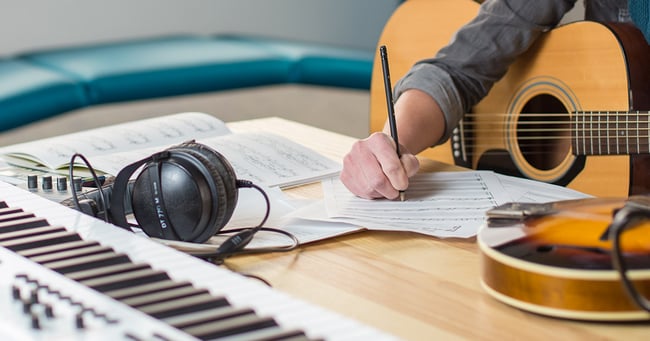How Words Change as a Song Progresses
by Gary Ewer

Over the 4 minutes of a good song, it’s normal for some things to stay the same while other things change. The kinds of things that usually get set up at the beginning and resist change would be the tempo and the basic feel of the song. The kinds of things that change would be the chord progressions, the melodies, and of course the lyrics.
How do they change? Typically, they change depending on the song’s section. A verse melody tends to be lower in pitch than a chorus melody. A verse chord progression tends to be longer and have a more “wandering” quality than a chorus progression, which is usually shorter and tonally stronger.
And you become aware that the kinds of words—the way you’d say something – will be different in a chorus than in a verse. It may not be something you’ve noticed before, but if you struggle with words, and getting your lyric to sound strong and to have an impact, you’ve got to know how words change over the length of a song.
Verse Lyrics
Song lyrics can be neatly categorized as being narrative, describing people, situations and circumstances, or emotional, expressing feelings and reactions to whatever the story has been about.
In general, the telling of the story or describing of circumstances happens in a verse. So you’ll want to use your verse to set up a good story, and keep emotion to a minimum.
The verse lyric of Gotye’s “Somebody That I Used to Know” is a great example. He uses the verse to sing about a situation that is, at its core, quite emotional, but he keeps that emotion controlled and minimal:
Now and then I think of when we were together
Like when you said you felt so happy you could die
Told myself that you were right for me
But felt so lonely in your company
But that was love and it's an ache I still remember.
As you can see, there is emotion, but it's controlled and measured.
Chorus Lyrics
A good chorus lyric allows the listener to generate and enjoy emotions that come from the story that’s been set up in the verse. That chorus lyric may add to the story, but its chief responsibility is to allow the listener to feel something. So that’s why you so often see exclamations (“Ooooh”, “yeah, yeah, yeah…”, or “whoa.” You’ll also see that a chorus lyric might use a catchy lyrical hook (“Ah, ha, ha, ha, stayin’ alive, stayin’ alive”), but in any case, its main responsibility is to have the audience feel something emotional.
The chorus of “Somebody That I Used to Know” shows that the difference between verse and chorus is usually subtle, but it’s important:
But you didn't have to cut me off
Make out like it never happened and that we were nothing
And I don't even need your love
But you treat me like a stranger and that feels so rough
No, you didn't have to stoop so low
Bridge Lyrics
If your song contains a bridge, you’ll notice that those kinds of lyrics are a little different again. Because a bridge (or middle-8) is used to finish the story and to get to the point of the song, it’s common to see bridge lyrics that give a narrative style “then-this-happened” line, and follow it quickly with a “so-then-I-felt-this” kind of responding line. Or it might be a series of lines that, while adding to the story, are filled with emotion.
In the hit song “Just Give Me a Reason” (Pink, Jeff Bhasker, Nate Ruess), the bridge is a perfect demonstrator of what the lyric is supposed to do. We get an important part of the story (our relationship is a bit of a mess, but “nothing is as bad as it seems…”) – a perfect blend of story and emotion:
Oh, tear ducts and rust, I'll fix it for us
We're collecting dust, but our love's enough
You're holding it in, you're pouring a drink
No, nothing is as bad as it seems, we'll come clean
Why This Is Important
Whether we’re talking about music, stories, or even just real life, we generate emotions based on what we hear or experience. Emotions don’t just happen without some sort of back story. So if you use your song lyric to basically say “I feel so bad”, but you don’t give any kind of background to why, it becomes an empty emotion, and audiences will feel confused and ultimately bored.
So as you write your next song, do this:
-
Write your verse lyric on one page and your chorus lyric on another.
-
Read your verse lyric to yourself, and try to assess it for its story-telling qualities. It doesn’t need to be devoid of emotion, but you should be aware that its main purpose is to tell the audience what’s going on.
-
Read the chorus to yourself, and try to assess it for the emotions it describes and generates. A good chorus doesn’t need to add to the story as such, but should express emotions that make sense when compared to the story of the verse.
When it works well, a song lyric acts as a kind of musical seesaw, where we feel emotion rising and falling. That kind of change over time is vital to keeping audiences listening and interested.
A couple of years ago I did a video that describes this important issue, using the song “Losing Sleep” by John Newman. You can see that lyric here: https://youtu.be/m4USyNw6-gk
Written by Gary Ewer, from “The Essential Secrets of Songwriting” blog. Gary Ewer is a music instructor, clinician, conductor and composer. He has been writing about songwriting on his “Essential Secrets of Songwriting” blog for the past 11 years. http://www.secretsofsongwriting.com
To enter the 24th Annual USA Songwriting Competition, go to: https://www.songwriting.net


